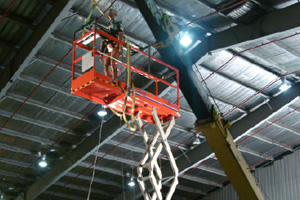NIOSH Researchers Partner with Equipment Manufacturers and Standards Committees to Protect Workers from Falls
October 2010
DHHS (NIOSH) Publication Number 2010-166

Researcher assesses hazards of working on aerial lifts and tests equipment designed to protect workers from falls.
A Story of Impact:
Aerial lifts are used in many industries, including construction and manufacturing, to elevate workers to job-sites above ground level. As new equipment designs and applications are developed, their use in the workplace increases. Between 1992 and 2003, 306 workers died from aerial lift incidents. Data indicate that most work-related deaths from aerial lifts involve scissor lifts and boom-supported lifts, such as cherry pickers and bucket trucks. In 2000, falls surpassed workplace homicide to become the second-leading cause of work-related death.
Aerial lift producers, national and international standards committees, and other related industry groups see a growing need for protecting workers from fall-related hazards. In response, the National Institute for Occupational Safety and Health (NIOSH) is evaluating issues such as aerial lift equipment, workplaces, fall-protection systems, and the interactions between these factors, and is progressing towards determining the causes of aerial lift fall injuries and fatalities in order to recommend solutions. These solutions will likely address improved equipment, design standards and criteria, standard operating procedures, and training materials. Aerial lift producers and related industry groups have strongly supported NIOSH in improving the safety of aerial lifts. NIOSH is partnering with the leading scissor lift producer and several standards committees to design, develop, test, and market safer aerial lift equipment and fall-protection systems, and develop specific design methods and criteria for future development. In addition, publishers with manufacturing audiences and aerial lift users have agreed to publish revised standard operating procedures, revised training materials, and additional information generated from this study. The findings of this study are anticipated to help improve worker safety and health and enhance manufacturers’ businesses. NIOSH recommends that this study be used to address the following needs.
Relevant Information
- Deaths involving aerial lifts increased from 19 in 1992 to 39 in 2003.
- Electrocutions, falls, and tip-overs cause most of the deaths involving aerial lifts. Other causes include being caught between the lift bucket or guardrail and the object, being struck by falling objects, or being thrown from the bucket if the boom or bucket is struck.
- Workers most often killed from aerial lift incidents are electrical workers, laborers, painters, ironworkers, and carpenters.
NIOSH Recommendations
- Specific design criteria and standards for aerial lifts and fall protection systems: Aerial lift producers will need specific guidelines to follow in order to design and build safer aerial lift equipment and make fall protection systems that are reliable.
- Equipment design software and information: Manufacturers will need resources to continue to design original aerial lift equipment and fall protection systems that adhere to the safety criteria and standards.
- Marketing materials: Users will need to be informed of the new safer equipment.
- Safety training materials: Users will need to learn and incorporate the methods shown to be the most effective in preventing and avoiding falls.
- Recommendations for standard operating procedures: Users will need to know what procedures to follow in order to best ensure their safety and how to improve current work practices.
![]()
![]()
![]()
![]()
Visit www.cdc.gov/niosh for more information on aerial lifts and fall injury prevention. Authors of Fall Injury Controls and Interventions for Aerial Lifts—Christopher Pan, Ren Dong, Brad Boehler, Mike McCann, Sharon Chiou, John Powers, Doug Cantis, Tim Lutz, Paul Keane, Dan Welcome, and Mahmood Ronaghi; NIOSH—received a 2009 Bullard-Sherwood Award in the Knowledge category.
